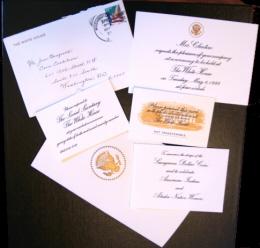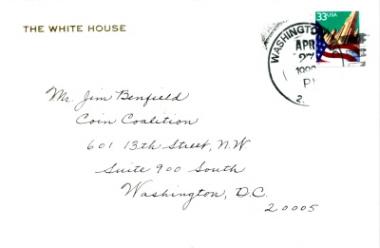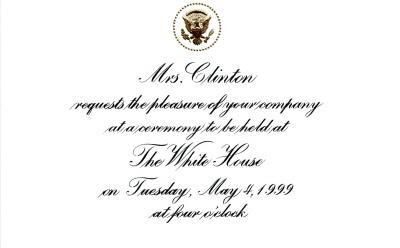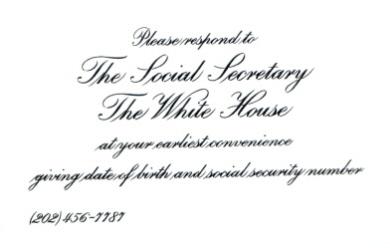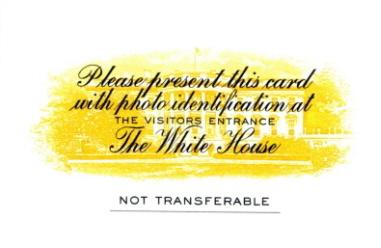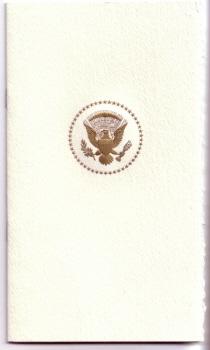Sacagawea Dollar Coin Unveiling
Remarks by First Lady Hillary Rodham Clinton
The White House
May 4, 1999
It is a pleasure to have all of you here today for this
historic occasion. I would like to extend a special word
of thanks to the American Indian and Alaskan Native
tribal leaders from across our great nation who have
traveled great distances to be with us today.
I also want to welcome our
distinguished members of Congress. And I would like the
members of Congress to please stand so that we can show
our appreciation of them. (Applause.)
I also want to recognize Treasury
Secretary [Robert] Rubin; the director of the United
States Mint, Philip Diehl; and today’s keynote
speaker and a friend to so many here today, LaDonna
Harris. (Applause.)
Appreciation, as well, to Kevin Gover
and Lynn Cutler for their tireless work in placing the
issues that are important to our American Indian and
Alaskan Native Americans at the forefront of today’s
national agenda. (Applause.)
I want to thank Zelda [Tillman] for
that beautiful Shoshone prayer. I also want to thank the
drummers and the dancers who have reminded us again of
the enduring power of Native American culture to stir our
imaginations and touch our hearts. And I want to pay
tribute to the Color Guard of Vietnam Era Veterans whose
presence here reminds us that Native Americans have one
of the most distinguished armed services records in our
entire society. (Applause.) We are deeply grateful for
the many sacrifices and contributions that they and so
many of you have made in defending America’s
freedoms.
Today we come from every corner of our
country, from a rich diversity of backgrounds, to honor a
common past and to imagine together a common future. We
pay particular tribute today to Indian women whose
cultural and spiritual contributions have enriched our
lives and whose leadership have helped to change the
course of history.
Almost 200 years ago, President Thomas
Jefferson would meet with Meriwether Lewis here at the
White House—often late into the night—to plan
the great exploration of America’s western frontier.
But at the time they were talking and planning, neither
man could have known that a young Shoshone woman would
play a pivotal role in that historic endeavor.
When Sacagawea joined the Lewis and
Clark expedition, she was only 15 years old, and she was
pregnant with her first child. She would be the only
woman, the only Indian, the only young person on that
trip. Yet even as she cared for her baby, she
demonstrated remarkable courage and ingenuity, serving
the expedition as an invaluable interpreter and guide.
Her knowledge of edible and medicinal plants also
contributed greatly to the physical health of the party.
The tremendous respect and admiration she evoked over the
course of the journey is evident throughout Clark’s
journals—journals which she saved from destruction
when one of their adventures on a river ended in the boat
capsizing. According to Captain Clark, her very presence
in the party of men represented a token of peace for all
who approached.
Sacagawea played an unforgettable role
in the history of our nation. I am pleased that just
recently the North Dakota Legislative Assembly has voted
unanimously to place a statue of Sacagawea in the Great
Hall of the United States Capitol where she will join
almost 100 other leaders revered and honored by the
people of this nation. (Applause.) Today we celebrate the
decision to honor this remarkable Shoshone woman in
another unique way—by placing her image on the first
U.S. dollar coin of the new millennium. With this
unveiling we celebrate not only the extraordinary
contributions that American Indian and Alaskan Native
women have made to our country over hundreds of years,
but we also acknowledge the even greater role they will
play in our future.
I want to congratulate and thank
Secretary Rubin and the U.S. Mint for its landmark
decision to set the tone and the very spirit of this new
century with this moving image. Every day this coin will
serve to remind us that we are a nation of many peoples
and cultures joined together by a shared vision of
freedom, justice, and respect.
And I want to thank the two artists who
designed this beautiful coin for all of us—Glenna
Goodacre and Tom Rogers. We are indebted to Secretary
Rubin and Phil Diehl as well for creating the most
inclusive coin selection process in the Mint’s
history, with its close consultation with the tribes and
unparalleled public outreach. Literally thousands of
Americans, from all walks of life and from communities
nationwide, were involved over the past year to bring us
the beautiful design we will unveil today. And many have
expressed their pride in the final choice. One letter
reads, for example, “As a woman, a mother, and a
Native American, I am pleased that we are going into the
year 2000 showing respect for the multiple roles women
have been carrying out since the beginning of time.”
I am also very pleased that we have
with us today the 2nd graders from Spring Ridge
Elementary School in Pennsylvania who voted in favor of
the design, as well as students from Kelley Elementary
from the Grand Tetons in Wyoming who wrote to Congress
encouraging the Sacagawea coin. I’m also very, very
pleased that this event is being cybercast so that young
people in classrooms around the country can participate
via the computer and the Internet.
Today as we honor and remember the life
and contributions of Sacagawea, we pay tribute as well to
other Native American women who have carried on her role
as pathmakers and breakers—the artists and doctors,
the educators and businesswomen, the tribal leaders who
have enriched our lives and nation and upon whose
shoulders we stand today. Leaders like Wilma Mankiller,
who could not be with us but who we honor as the first
Cherokee woman to be elected principal chief of her
nation. I know we all join together to wish her a speedy
recovery.
We recognize other leaders among us:
Hattie Kauffman, the first Native American network news
reporter; Luci Tapahonso, an internationally renowned
writer and educator of the Navajo nation; Suzan Shown
Harjo, a poet and curator who has helped Indians recover
some of their most sacred lands and protect their ancient
cultures; and LaDonna Harris, who has been such an
inspiration for peace-loving people everywhere.
Last summer, I was privileged to
experience the accumulated wisdom of generations of
Native American women when I met with eight Iroquois clan
mothers in upstate New York. They spoke to me about some
of the lessons they pass down to their children and their
grandchildren—that we must walk softly on the Earth,
and that every decision we make, and every action we
take, must be judged not only on its impact on us today,
but on the impact it will make on the next seven
generations.
This belief in the importance of giving
gifts to the future can be seen in the traditional
reverence for the land, and the close-knit family and
tribal ties and the understanding that diverse peoples
can come together to build one nation and yet protect the
individual rights of all. And these are not just the
values of Native Americans. They are deeply ingrained in
the American spirit as well.
In two weeks I will have another
opportunity to explore the extraordinary culture and
heritage of Native Americans when I travel to the
beautiful Southwest. I will visit the ancient cliff
dwellings of the Ancestral Puebloans, such as those at
Mesa Verde, as well as living communities like Acoma. And
I will see some of you again, including members of the
All-Indian Pueblo Council. This trip is part of the White
House Millennium Council’s Save America’s
Treasures program, which is helping to preserve the sites
and artifacts and cultural and artistic heritage that
tell the story of America.
Yet even as we celebrate the historic
and ongoing contributions of Indians to the development
of America, we have to recognize that we have not always
lived up to our own legal and moral obligations. While
some in Indian country have made remarkable progress, far
too many remain stranded in a cycle of poverty—their
dreams further diminished by poor health, inadequate
employment opportunities, and dilapidated schools.
I’m very proud of my husband’s commitment to
preserving and strengthening the sovereignty of Native
American tribes. He and all of us in the Administration
are also deeply committed to enhancing tribal economic
development, investing in tribal schools, and enhancing
the well-being of families.
At last year’s first-ever White
House Conference on Economic Development in Indian
Country, the President announced several important
initiatives to boost economic development and create
much-needed jobs. The President’s fiscal year 2000
budget request includes a “new markets”
initiative that, through tax incentives and expanded
access to capital, could have a dramatic impact on the
quality of life in Indian country in the years ahead. The
President is also seeking to expand health care coverage
for Native American children and to end the unacceptable
health disparities that so unfairly penalize poor and
minority citizens, particularly women and children.
(Applause.)
But probably our greatest
challenge—and surely the most meaningful and lasting
contribution we can make to the next generation—is
to strengthen the educational opportunities available for
Native American children. I would like to thank the many
leaders here today who are working to ensure that Native
American children get the education and the skills they
need to thrive in this new century. Leaders like Dr.
Janine Pease-Pretty On Top, who became the first woman of
Crow descent to earn her doctorate and who has worked
tirelessly since then to open up the same doors of
opportunity to others who would follow. (Applause.)
The President took on an important step
last year when he issued an executive order directing
federal agencies to improve Native American achievements
in math and reading, to raise high school graduation
rates, and to increase the number of Native Americans who
attend college. This year’s fiscal year 2000 budget
takes another step forward, calling for the recruitment
of 1000 new teachers for areas with high concentrations
of American Indian and Alaskan Native students. The
budget also calls for dramatic increases in construction
funding for BIA schools and a new bond initiative to
leverage private resources for BIA-funded schools. But we
must do more.
So it is with great pleasure that I
announce new legislation which will be shortly forwarded
to Congress to further enhance education for Indian
children. This legislation creates the American Indian
Education Foundation, which will be a non-profit entity
authorized to accept and administer private funding to
enhance educational opportunities for Native students
from early childhood through high school. Foundation
funds can be used to support teacher development and
family literacy programs, to help create “best
practices,” and to develop cultural programs for use
in the schools.
I want to thank all of the
Congressional sponsors of this important piece of
legislation who are with us today: Senators Inouye,
Dorgan and Conrad; and Representatives Kennedy, Kildee,
Kolbe, Pomeroy and Udall. You have truly given a gift to
the future.
You know, there are many members of
Congress who have been strong supporters of the needs of
people in Indian country. But I want to single out one
man who has been the conscience and the voice for so
many. I’d like to ask him to stand—Senator
Daniel Inouye. (Applause.)
Today as we honor the past with this
coin of Sacagawea and her baby, let us commit ourselves
to a future where all children have the opportunity to be
healthy, safe, and cared for. Where all children have the
opportunity to receive the quality education they need.
And as we build that common future, let’s heed the
words of the great Iroquois oath of the peacemaker:
“You shall look and listen to the welfare of the
whole people; and have always in view not only the
present, but the coming generations of the unborn, of the
future nation.” That is our obligation and, I hope,
our commitment.
It is now my great honor to introduce a
Native American leader who has lent her remarkable talent
to the cause of peace and to the delivery of justice. A
leading citizen of the Comanche Nation and a passionate
voice for Native American rights, she has devoted her
life to civil rights, the women’s movement, and
world peace. Please join me in welcoming LaDonna Harris.
(Applause.)
[HARRIS SPEAKS.]
Thank you, LaDonna. It is now my
pleasure to introduce the man who has many
mothers—Assistant Secretary for Indian Affairs,
Kevin Gover. He is an enrolled member of the Pawnee Tribe
of Oklahoma, and has been instrumental in developing a
greater understanding—within the Administration and
across the country—about the challenges facing
Native Americans today. We applaud his commitment to
tribal sovereignty and his strong advocacy for increased
attention to the needs of young people in Indian country.
Please welcome Assistant Secretary Kevin Gover.
(Applause.)
[GOVER SPEAKS.]
Thank you very much, Kevin. Now I would
like to introduce the person who shepherded this whole
process, and has not only made a contribution to our
understanding of our past by this coin, but has
contributed so much to the Administration and to our
country in so many ways. And that is Secretary of the
Treasury Robert Rubin. After his remarks, he will
introduce Glenna Goodacre and Tom Rogers—the two
artists—and U.S. Treasurer MaryEllen Withrow, who
will join Secretary Rubin and Philip Diehl and myself in
unveiling our new millennium coin.
I would like to invite to join us one
additional person who has no idea I’m going to do
this to her. But I would like, when the others come up to
the stage, to ask Tahnee Rose Robinson, a young Shoshone
woman, to come up. Because I think it would be a very
fitting moment for us to be looking at the future while
we honor the past.
So with that, please join me in
welcoming Secretary Rubin. (Applause.)
[RUBIN SPEAKS AND UNVEILS COIN.]
It is my pleasure now to invite Joanne
Shenandoah to close this memorable event with a song. A
member of the Iroquois confederacy and one of
America’s foremost Native American recording
artists, Joanne has transformed audiences around the
world with the beauty and power of her Native American
musical traditions. Together with her sister Diane and
her daughter Leah, she will sing for us a song she has
written in honor of Sacagawea—and as a tribute to
all women who sustain life and serve as caretakers of our
precious planet.
[SHENANDOAH SINGS.]
Thank you, Joanne, for that beautiful
song. And I want to thank all of you for coming to the
White House to this historic celebration. Now will you
please rise as the flags are removed from the Pavilion by
the Vietnam Era Veterans Inter-Tribal Association? The
Eyabay Drum Group will sing a traveling song to wish you
well on your journey. But before you leave, I would like
to invite all of you to visit the White House—the
People’s House. But first, I’d like to invite
the elected tribal leaders to join me at the South
Portico for a group photograph. Again, I wish every one
of you a safe trip, and may God bless you all.
|
